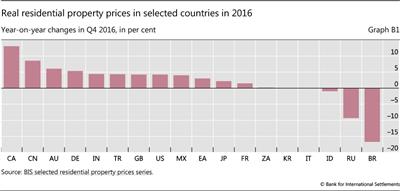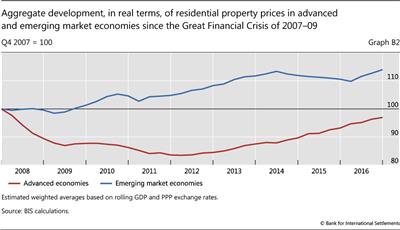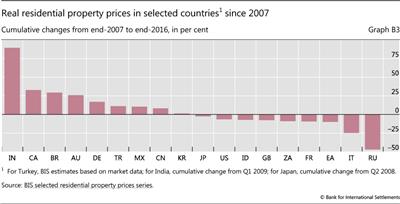Residential property price developments
Residential property prices increased significantly in almost all advanced economies (AEs) during 2016. On average, prices grew by 4% in real terms - ie deflated by the consumer price index (CPI) - on a year-on-year basis. Their growth was particularly marked in Canada. Prices also rose strongly, though more moderately, in Australia, the United Kingdom and the United States. They grew less in Japan and in the euro area, where a significant increase in Germany was offset by stable prices in Italy (Graph B1).
Most of the emerging market economies (EMEs) also experienced strong price increases during 2016. Prices rose, for example, in China, India, Mexico and Turkey, but they fell markedly in Russia and even more so in Brazil. On average, real prices were up by 3% for EME regions as a whole (Graph B1).
After a sharp decline following the Great Financial Crisis (GFC) of 2007-09, average real residential property prices in AEs bottomed out in 2011-12. They have now almost recouped their post-GFC declines (Graph B2). At the end of 2016, real prices were only modestly below their 2007 levels in the United Kingdom and the United States (by 6-7%). The gap was slightly wider for the euro area (by 10%), with important disparities across this region: real prices are now significantly above their pre-GFC levels in Germany, but they are well below this benchmark in France and even more so in Italy. Turning to those other AEs which were much less affected by the GFC, real prices are almost comparable to their 2007 levels in Japan, whereas they are significantly above them in Canada and Australia (Graph B3).
After a marked expansion in the early 2010s, real residential property prices in EMEs have almost stabilised since 2014, at almost 15% above the levels registered in 2007 (Graph B2). Compared with the period of the GFC, prices have almost doubled in India. They are one third higher in Brazil, despite the significant downward correction observed most recently, and are also slightly higher in China, Mexico and Turkey (by around 10% in each case). By contrast, prices are still below their 2007 levels in Indonesia and South Africa, and they have roughly halved in Russia (Graph B3).
 A note focusing on the most recent developments is published in February, August and November. Q1 2017 data are already available in the BIS data sets for some countries, but Q3 and Q4 2016 data are not yet available for two and three countries, respectively.
A note focusing on the most recent developments is published in February, August and November. Q1 2017 data are already available in the BIS data sets for some countries, but Q3 and Q4 2016 data are not yet available for two and three countries, respectively.  Price developments since early 2008 for Japan and early 2009 for India. For China, BIS calculation based on the average of the prices reported for the 70 largest cities.
Price developments since early 2008 for Japan and early 2009 for India. For China, BIS calculation based on the average of the prices reported for the 70 largest cities.
References:
Scatigna, M and R Szemere (2015): "BIS collection and publication of residential property prices", Irving Fisher Committee Bulletin, no 39, April.
Scatigna, M, R Szemere and K Tsatsaronis (2014): "Residential property price statistics across the globe", BIS Quarterly Review, September, pp 61-76.
Shim, I and K Kuttner (2013): "Can non-interest rate policies stabilise housing markets? Evidence from a panel of 57 economies", BIS Working Papers, no 433, November.
Tissot, B (2014): "Monitoring house prices from a financial stability perspective - the BIS experience", International Statistical Institute Regional Statistics Conference, November.




